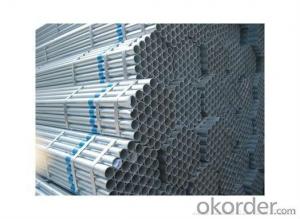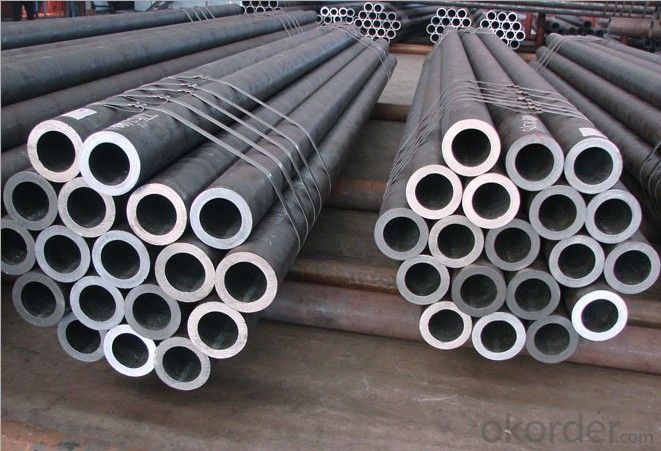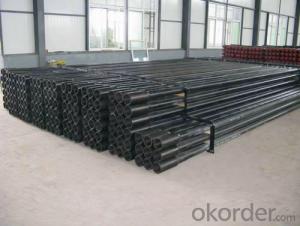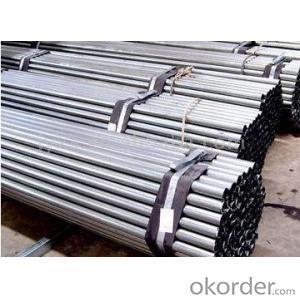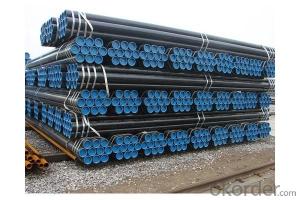ERW Galvanized Carbon seamless Steel Pipe
- Loading Port:
- Tianjin
- Payment Terms:
- TT or LC
- Min Order Qty:
- 25 m.t.
- Supply Capability:
- 10000 m.t./month
OKorder Service Pledge
OKorder Financial Service
You Might Also Like
We are company that have many years experience and professional manager team and engineer team and sales team, sure we will provide you high quality of pipe and professioanl service. Seamless pipe possesses a hollow section and without seam around the strip steel. It is made with solid bar or steel ingot by perforating machine. As the facture process does not include any welding, seamless pipes are considered to be stronger and more durable. Generally speaking, seamless pipe has better pressure resistance and security than other classifications, and was usually more easily available than welded pipe.
2、Main Features of the Seamless Pipe:
• High working accuracy
• High strength
• Small inertia resistance
• Strong therming dissipine ability
• Good appearance
• Reasonble price
3、Seamless Pipe Specification:
Standard | GB, DIN, ASTM ASTM A106-2006, ASTM A53-2007 |
Grade | 10#-45#, 16Mn 10#, 20#, 45#, 16Mn |
Thickness | 8 - 33 mm |
Section Shape | Round |
Outer Diameter | 133 - 219 mm |
Place of Origin | Shandong, China (Mainland) |
Secondary Or Not | Non-secondary |
Application | Hydraulic Pipe |
Technique | Cold Drawn |
Certification | API |
Surface Treatment | factory state or painted black |
Special Pipe | API Pipe |
Alloy Or Not | Non-alloy |
Length | 5-12M |
Outer Diameter | 21.3-610mm |
Grade | 20#, 45#, Q345, API J55, API K55, API L80, API N80, API P110, A53B |
Standard | ASME, ASTM |
1) Material:20#(ASTM A 106/A53 GRB.API5LGRB,GB),45#,16Mn,10#.
2) Specification range: OD: 21.3-610mm, WT:6-70mm, length:6-12m or according to the requirement of clients.
3) Executive standards: GB, ASME API5L.ASTM A 106/A53,Despite of the above standards, we can also supply seamless steel pipe with standard of DIN, JIS, and so on, and also develop new products according to the requirements of our clients!
4) Surface: black lacquered, varnish coating or galvanized.
5) Ends: Beveled or square cut, plastic capped, painted.
6) Packing: bundles wrapped with strong steel strip, seaworthy packing.
4、Packaging & Delivery:
Packaging Details: | seaworthy package, bundles wrapped with strong steel strip |
Delivery Detail: | 15-30days after received 30%TT |
5、FAQ of Seamless Pipe:
①How is the quality of your products?
We have many years business experience in this area, and we have professional engineer and manager team and sure we can provide you high quality production and professional service.
②How about price?
Yes, we are factory and be able to give you lowest price below market one, and we have a policy that “ for saving time and absolutely honest business attitude, we quote as lowest as possible for any customer, and discount can be given according to quantity”,if you like bargain and factory price is not low enough as you think, just don’t waste your time.Please trust the quotation we would give you, it is professional one.
③Why should you chose us?
We can give you both.Additionally, we can also offer professional products inquiry, products knowledge train(for agents), smooth goods delivery, exellent customer solution proposals.Our service formula: good quality+good price+good service=customer’s trust
SGS test is available, customer inspection before shipping is welcome, third party inspection is no problem.
6、Seamless Pipe Images:
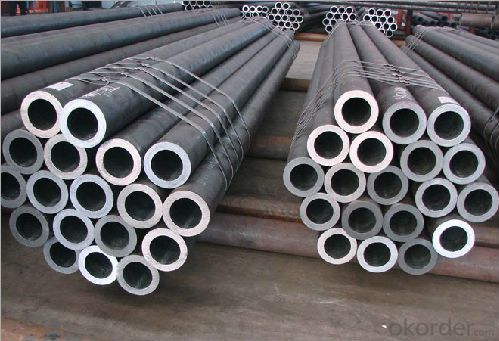
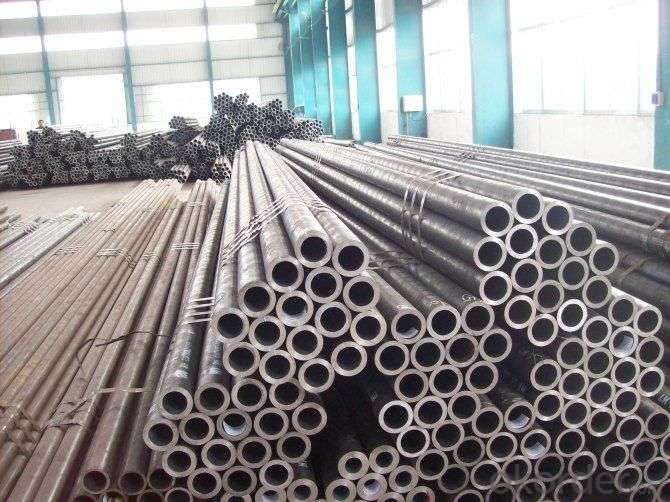
- Q: How are steel pipes used in the automotive manufacturing industry?
- Steel pipes are commonly used in the automotive manufacturing industry for various applications such as exhaust systems, fuel lines, and structural components. They provide durability, strength, and resistance to heat and corrosion, making them ideal for withstanding the harsh conditions of vehicles.
- Q: How are steel pipes coated for insulation purposes?
- Steel pipes are commonly coated for insulation purposes using various methods and materials. One common method is the application of a thermal insulation coating. This coating is usually a high-performance polymer or epoxy-based material that is applied to the surface of the steel pipe. Before the coating is applied, the steel pipe is usually cleaned thoroughly to remove any dirt, grease, or rust that may be present on its surface. This is typically done through a process called abrasive blasting, where small particles are propelled at high speed to remove contaminants and create a clean, rough surface for the coating to adhere to. Once the surface is prepared, the thermal insulation coating is applied using different techniques such as spraying, brushing, or rolling. The coating is carefully applied in multiple layers to ensure proper coverage and thickness. This helps to create a barrier between the steel pipe and the external environment, preventing heat transfer and minimizing energy loss. In addition to thermal insulation coatings, steel pipes can also be coated with materials such as polyurethane foam or mineral wool. These materials provide excellent thermal insulation properties and are often used in applications where high-temperature resistance is required. Overall, steel pipes are coated for insulation purposes through a combination of surface preparation and the application of specialized coatings. These coatings help to reduce heat loss, increase energy efficiency, and protect the steel pipe from corrosion and other environmental factors.
- Q: What are the factors to consider when designing a steel pipe system?
- To ensure the functionality, durability, and efficiency of a steel pipe system, several factors must be taken into account during the design process: 1. It is crucial to determine the maximum pressure and temperature the system will be exposed to. This information is essential for selecting the appropriate pipe material, thickness, and jointing method to withstand the system's operating conditions. 2. The selection of the right material for the steel pipes is important. Factors such as corrosion resistance, strength, and cost should be considered. Common materials include carbon steel, stainless steel, and alloy steel. 3. Calculating the adequate pipe size and wall thickness is essential to ensure the required flow rate and pressure drop within the system. The pipe size directly affects the system's efficiency and must be chosen based on the anticipated flow rates and pressure losses. 4. Proper support and anchoring are critical to prevent sagging, movement, and stress on the steel pipe system. The design should take into account the weight of the pipes, the fluid being transported, and any external forces acting on the system. 5. Expansion joints or loops should be incorporated to allow for thermal growth and contraction, preventing damage and distortion caused by temperature variations. 6. Understanding the properties of the fluid being transported, such as corrosiveness, viscosity, and potential for sedimentation or scaling, is important in selecting the appropriate pipe material and protective coatings or linings. 7. Consideration should be given to the accessibility of the system for installation, inspection, and maintenance purposes. The design should include proper access points, valves, and fittings to facilitate easy maintenance and repairs. 8. Environmental factors such as extreme temperatures, humidity, or corrosive substances should be taken into account when selecting the pipe material, protective coatings, and insulation. 9. Compliance with industry standards, codes, and regulations is essential. The design should adhere to safety guidelines and applicable building codes to ensure the integrity and longevity of the pipe system. 10. The overall cost of the steel pipe system, including material, installation, maintenance, and energy consumption, should be considered. Balancing cost-effectiveness with performance requirements is crucial in achieving an efficient and economical design. By considering these factors, engineers and designers can create a steel pipe system that is suitable for its intended purpose, ensuring its longevity, reliability, and safety.
- Q: What is the diameter of the steel tube DN20?
- Usually the nominal diameter is nominal for cast iron pipe, steel pipe joints, concrete pipe pipe, seamless steel pipe does not use this notation (with diameter * wall thickness). With nominal diameter pipeline accessories, meaning with tube.
- Q: Can steel pipes be used for gas transportation?
- Yes, steel pipes can be used for gas transportation. Steel is a commonly used material for gas pipelines due to its strength, durability, and resistance to corrosion. Steel pipes are able to withstand high pressures and are suitable for transporting both natural gas and propane. They are also capable of withstanding extreme temperatures, making them ideal for gas transportation in various environments. Additionally, steel pipes can be welded together, allowing for a seamless and continuous pipeline system. However, it is important to ensure that the steel pipes used for gas transportation are properly coated and protected against corrosion to prevent any leaks or damage to the pipeline.
- Q: Can steel pipes be used for underground oil and gas pipelines?
- Yes, steel pipes can be used for underground oil and gas pipelines. Steel is a commonly used material for such pipelines due to its strength, durability, and ability to withstand high pressure and extreme temperatures. Additionally, steel pipes can be coated or lined with corrosion-resistant materials to protect them from the corrosive properties of oil and gas.
- Q: Can steel pipes be coated for aesthetic purposes?
- Yes, steel pipes can be coated for aesthetic purposes. Coating steel pipes not only adds a visually appealing finish but also provides protection against corrosion and other environmental factors. There are various coating options available for steel pipes, such as powder coating, epoxy coating, and vinyl coating, among others. These coatings can be applied in different colors and textures to enhance the appearance of the pipes and complement the surrounding environment. Whether in industrial settings, architectural projects, or decorative applications, coating steel pipes can transform them into visually appealing elements while maintaining their structural integrity.
- Q: Can steel pipes be used in marine environments?
- Indeed, the usage of steel pipes is viable in marine environments. Steel, being a robust and sturdy material, possesses the capability to endure the severe conditions prevalent in marine surroundings, encompassing saltwater exposure, wave impacts, and corrosion. Nevertheless, it is imperative to meticulously choose the appropriate steel variant and implement suitable protective measures to avert corrosion. Stainless steel and corrosion-resistant alloys are often employed in marine applications due to their exceptional resistance against corrosion and ability to withstand continuous saltwater exposure. Furthermore, the application of coatings such as epoxy or zinc can be an effective means of fortifying steel pipes against corrosion. Consistent maintenance and inspections are also pivotal in ensuring the durability and functionality of steel pipes in marine settings.
- Q: How are steel pipes tested for quality and strength?
- Steel pipes are tested for quality and strength through various methods, including destructive and non-destructive testing. Destructive testing involves subjecting the pipes to extreme forces, such as tension, compression, and bending, to determine their mechanical properties and structural integrity. Non-destructive testing methods, such as ultrasonic testing, magnetic particle testing, and radiographic testing, are used to detect any defects or inconsistencies in the pipes without causing damage. These rigorous testing procedures ensure that steel pipes meet the required quality and strength standards before being used in various applications.
- Q: How are steel pipes used in the construction of railway tracks?
- Steel pipes are commonly used in the construction of railway tracks as they provide a strong and durable foundation. These pipes are usually used as support structures for the tracks, serving as a base on which the rails are laid. They help to distribute the weight of the trains evenly, ensuring stability and reducing the risk of track failure. Additionally, steel pipes are used for drainage purposes, allowing water to flow freely and preventing damage to the tracks.
Send your message to us
ERW Galvanized Carbon seamless Steel Pipe
- Loading Port:
- Tianjin
- Payment Terms:
- TT or LC
- Min Order Qty:
- 25 m.t.
- Supply Capability:
- 10000 m.t./month
OKorder Service Pledge
OKorder Financial Service
Similar products
Hot products
Hot Searches
Related keywords
